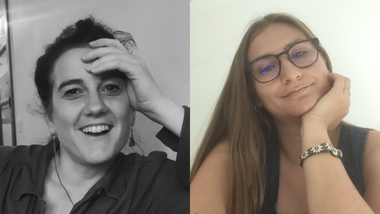ERC Proof of Concept Grant for two Ghent University researchers
(28-07-2023) Ghent University researchers Nele Vandersickel (left) and Anna Kaczmarek (right) win a Proof of Concept Grant. This allows them to bridge the gap between their groundbreaking research and the early stages of commercialization.
The European Research Council (ERC) has announced 66 new recipients of its Proof of Concept Grant scheme. Worth €150 000 each, their grants will be used to explore the commercial or societal potential of the results of their research projects. The winning projects have been selected out of 183 evaluated proposals. The new grants will be awarded to researchers working in 14 countries. In Belgium, five researchers are awarded, of which two at Ghent University: Nele Vandersickel and Anna Kaczmarek.
Discover the winning projects
Automatic analysis of cardiac arrhythmia
Nele Vandersickel researches the use of topology to revolutionize atrial tachycardia treatment (AT). AT is a prevalent form of a cardiac arrhythmia that can have detrimental impacts on a person's health. The complexity of the patterns of this arrhythmia and unclear nomenclature hinders precise diagnosis of complex cases of AT and makes optimal treatment challenging and error prone. Suboptimal treatment can result in severe outcomes such as heart failure, stroke, and pacemaker implantation due to overablation-induced atrial dysfunction.
In this proposal, we introduce a diagnostic tool called Directed Graph Mapping (DGM), which offers a unique classification system based on clear and precise mathematical criteria using topological principles, allowing for the accurate diagnosis and differentiation of various types of AT. DGM can automatically analyze a given case of AT, providing consistent and reliable results, paving the way for the optimization of the ablation strategy.
DGM can not only diagnose the current AT but also predict hidden slower ATs, which might appear depending on the chosen ablation target. By being able to predict the hidden ATs, we can revolutionize the treatment of ATs, as these hidden ATs can be treated already after the measurement of the first anatomical map. Therefore, our tool holds the potential to significantly expedite the ablation procedure.
For this project, we will conduct a prospective study involving a minimum of 15 hospitals in Belgium that specialize in AT ablations to further validate the effectiveness and sustainability of our proposed solution while involving a broad range of electrophysiologists. By discussing with electrophysiologists, we learned that their interest in DGM influences mapping systems. If they recognize the value of DGM for treating AT, mapping companies may adopt our technology so we can actually help patients in the clinic with our technology.
Nanothermometers from degradable nanomaterials
Anna Kaczmarek researches new non-toxic, degradable materials for monitoring temperature for disease diagnosis and for usage in treatment control. Thermal monitoring plays a paramount role both in disease diagnostics and treatment control.
Employing the luminescence thermometry technique for in vivo temperature assessment has attracted substantial interest in the past decade. However, despite the great promise and potential impact, to date, luminescence nanothermometers have still not surpassed preclinical stages. This is heavily related to issues of toxicity, nano-safety and biocompatibility, as the majority of proposed luminescence nanothermometers rely on heavy metals (e.g. quantum dots, rare-earth nanoparticles).
To move towards usage of luminescent nanothermometers on the clinical level there is a clear need to resolve these obstacles, which is the goal of project LUMITOOLS. To achieve this goal in the coming years, at this stage moving away from nanothermometers built of heavy metals seems well judged, at least until current toxicity and accumulation risks can be suitably addressed and rectified.
This project focuses on developing novel ratiometric thermometer materials constructed from degradable nanomaterials. Developing stable, well-performing nanothermometers, which completely degrade after they have done their job, would constitute an important advancement for future research efforts on in vivo thermometry applications. This project led by PI Anna Kaczmarek would allow delivering nanothermometers with true potential for implementation in clinics in the near future.
More about the ERC
The ERC, set up by the European Union in 2007, is the premier European funding organisation for excellent frontier research. It funds creative researchers of any nationality and age, to run projects based across Europe. The ERC offers four core grant schemes: Starting Grants, Consolidator Grants, Advanced Grants and Synergy Grants. With its additional Proof of Concept Grant scheme, the ERC helps grantees to bridge the gap between their pioneering research and early phases of its commercialisation.
The ERC is led by an independent governing body, the Scientific Council, whereof VIB-UGent professor Dirk Inzé is a member. Since 1 November 2021, Maria Leptin is the President of the ERC. The overall ERC budget from 2021 to 2027 is more than €16 billion, as part of the Horizon Europe programme, under the responsibility of the European Commissioner for Innovation, Research, Culture, Education and Youth, Mariya Gabriel.
Researchers within and outside of Ghent University who wish to apply for an ERC Grant with our university as host institution, can contact the EU Team for advice and support.
Contact
- EU-team UGent, eu-team@ugent.be
- nele.vandersickel@ugent.be
- anna.kaczmarek@ugent.be
